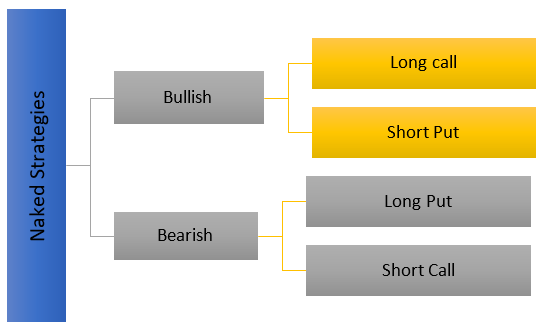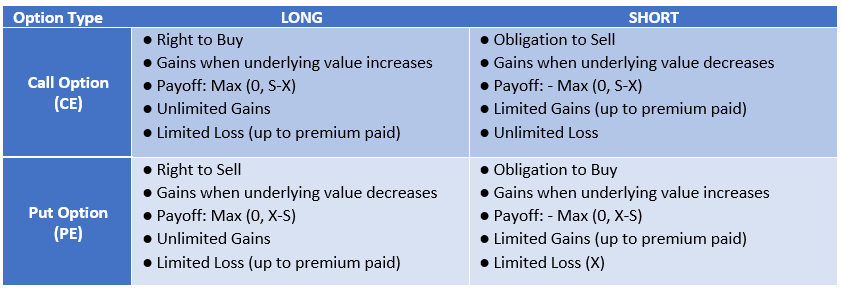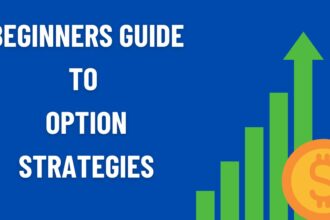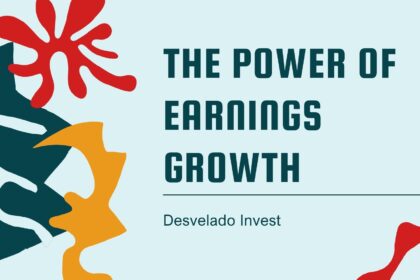Written By: Rhythm Garg
Once, there lived a curious investor named Dan. Dan was intrigued by the concept of options, a magical tool that could unlock the market’s potential, as he could no longer invest just through one financial asset but through other ones, which were called derivatives.
In this article, we will understand the various options strategies that are to be used by Dan. The most common trading strategies for beginners using options include naked buying & selling, spreads, straddles, and strangles.


Naked Strategies
These strategies for buying and selling are used when the investor is either bullish or bearish on the market in a single position and either goes Long or Short in a Call or Put Option. This might sound complicated but let’s dive into a simple explanation for it.
As you know these terms, Spot Price (S) and Strike Price (X) which we have explained in the previous articles, we will be working on these terms with the help of examples.
- Long Call: It’s a simple strategy where you buy a call option (you are the buyer here), which gives you the right, but not the obligation, to buy a specific asset (like a stock (S)) at a predetermined price (strike price (X)) on or before a specific date (expiration date). You buy this option when you expect the market to rise.
For example, Let’s say the Nifty index is currently trading at 24,500 points and Dan is bullish on the market and expects the market to rise in the near future, he decides to buy a Nifty 24,800 Call option, which expires in one month. The premium for this option is ₹ 50.
What does this mean?
- Right to Buy: Dan now has the right to buy the Nifty at 24,800 points, regardless of its actual market price, until the option expires.
- Premium Paid: Dan have paid ₹ 50 for this right with a lot size of 25 so the premium paid is 25 x 50 = ₹1250.

- Profit: If the Nifty rises to 25,000, he can exercise his option to buy the Nifty at 24,800 and immediately sell it at the market price of 25,000.
- Profit per share: ₹ 200 (25,000 – 24,800)
- Net Profit: ₹ 150 (₹ 200 – ₹ 50 premium paasid) = ₹ 150 x 25 = ₹ 3750, therefore the return on invested capital he would get is ₹ 5000
- Unlimited Profit Potential: If the Nifty rises significantly, your profit potential is theoretically unlimited.

- Loss: If the Nifty remains below 24,800, his option will expire worthless.
- Maximum Loss: ₹ 50 (the premium paid), i.e. ₹ 1250

- Long Put: It’s a simple strategy where you buy a put option (you are the buyer here), which gives you the right, but not the obligation, to sell a specific asset (like a stock (S)) at a predetermined price (strike price (X)) on or before a specific date (expiration date). You buy this option when you expect the market to fall
For example, Let’s say the Nifty index is currently trading at 24,500 points and Dan is bearish on the market and expects the market to fall in the near future, he decides to buy a Nifty 24,300 Put option, which expires in one month. The premium for this option is ₹ 100.
What does this mean?
- Right to Sell: Dan now has the right to sell the Nifty at 24,300 points, regardless of its actual market price, until the option expires.
- Premium Paid: Dan has paid ₹ 100 for this right with a lot size of 25 so the premium paid is 25 x 100 = ₹ 2500.

- Profit: If the Nifty falls to 24,000, he can exercise his option to sell the Nifty at 24,300 and immediately sell it at the market price of 24,000.
- Profit per share: ₹ 300 (24,300 – 24,000)
- Net Profit: ₹ 200 (₹ 300 – ₹ 100 premium paid) = ₹ 200 x 25 = ₹ 5000, therefore the return on invested capital he would get is ₹ 7500
- Unlimited Profit Potential: If the Nifty falls significantly, your profit potential is theoretically unlimited.

- Loss: If the Nifty remains above 24,300, his option will expire worthless.
- Maximum Loss: ₹ 100 (the premium paid), i.e. ₹ 2500.

- Short Call: It’s a strategy where you sell a call option (you are the seller here), which gives the buyer the right, but not the obligation as the obligation belongs to the seller of option, to buy a specific asset (like a stock) at a predetermined price (strike price) on or before a specific date (expiration date). You sell this option when you expect the market to fall.
For example, Let’s say the Nifty index is currently trading at 24,500 points and Dan is bearish on the market and expects the market to fall in the near future, he decides to Sell a Nifty 24,300 Call option, which expires in one month. The premium for this option is ₹ 100.
What does this mean?
- Obligation to Sell: Dan is obligated to sell the Nifty at 24,300 points, regardless of its actual market price, if the option buyer chooses to exercise it.
- Premium Received: He has received ₹ 150 upfront premium for this obligation.

- Profit: If the Nifty remains below 24,300 the option buyer will not exercise their right to buy. Dan keeps the entire premium of ₹ 150 as profit, i.e. ₹ 150 x 25 = ₹ 3750 which is the maximum profit received.
- Time Decay: As the expiration date approaches, the value of the option decreases, which can work in his favour as he is the option seller.

- Loss: If the Nifty rises above 24,300, the option buyer may exercise their right to buy the Nifty at 24,300. Dan will have to buy the Nifty at the market price (which is higher than 24,300) and sell it to the option buyer at 24,300.
- Unlimited Loss Potential: If the Nifty rises significantly, Dan’s loss potential is theoretically unlimited.

- Short Put: It’s a strategy where you sell a put option (you are the seller here), which gives the buyer the right, but not the obligation as the obligation belongs to the seller of option, to sell a specific asset (like a stock) at a predetermined price (strike price) on or before a specific date (expiration date). You sell this option when you expect the market to rise.
For example, Let’s say the Nifty index is currently trading at 24,500 points and Dan is bullish on the market and expects the market to rise in the near future, he decides to sell a Nifty 24,800 Put option, which expires in one month. The premium for this option is ₹ 200.
What does this mean?
- Obligation to Buy: Dan is obligated to buy the Nifty at 24,800 points, regardless of its actual market price, if the option buyer chooses to exercise it.
- Premium Received: Dan received ₹ 200 upfront premium for this obligation.

- Profit: If the Nifty remains above 24,800 the option buyer will not exercise their right to buy. Dan can keep the entire premium of ₹ 200 as profit, i.e. ₹ 200 x 25 = ₹ 5000 which is the maximum profit received.
- Time Decay: As the expiration date approaches, the value of the option decreases, which can work in his favor as he is the option seller.

- Loss: If the Nifty falls below 24,800, the option buyer may exercise their right to sell the Nifty at 24,800. Dan will have to buy the Nifty at the market price (which is lower than 24,800) and sell it to the option buyer at 24,800.
- Maximum Loss: Dan’s maximum loss is limited to the difference between the strike price and the market price, minus the premium received.


While these are the fundamental strategies to reap returns in bullish and bearish markets, the options market offers a vast array of complex strategies. As you gain experience, you can explore more advanced techniques. While options offer exciting opportunities, they also come with inherent risks. It’s essential to manage risk effectively and to have a clear understanding of your risk tolerance.






